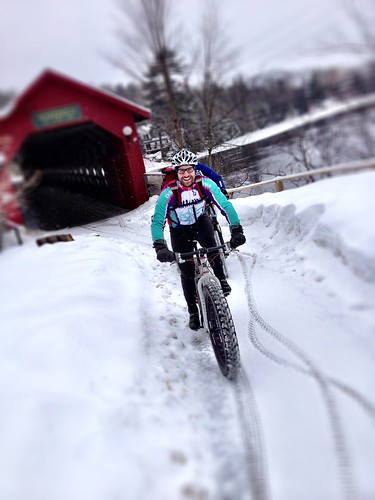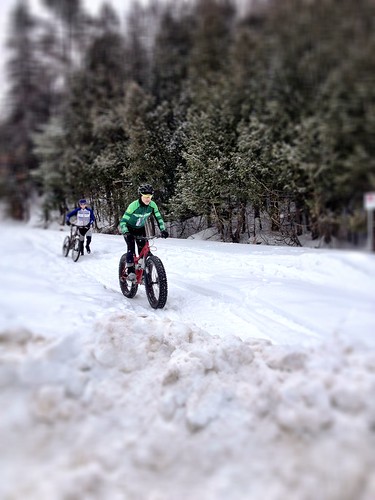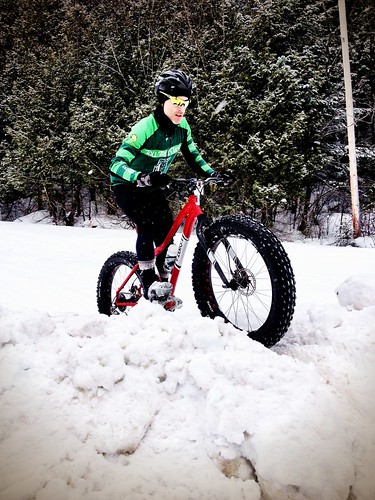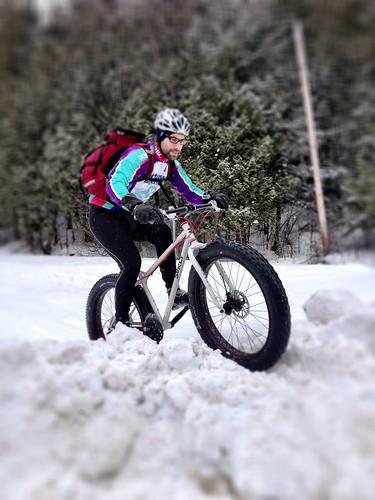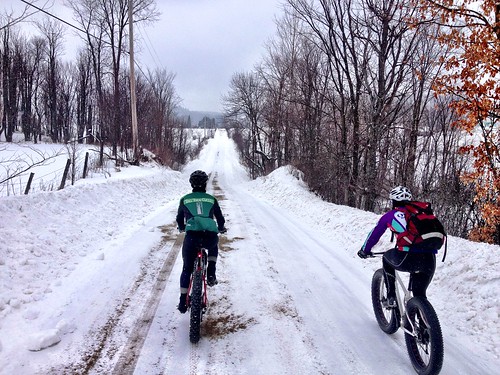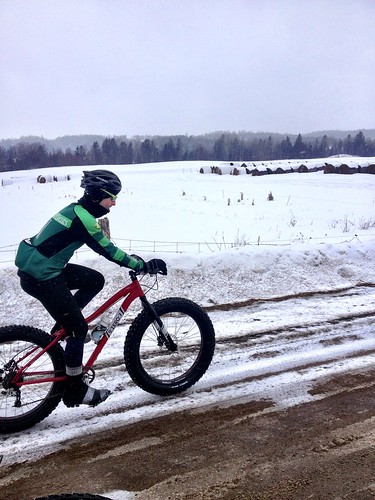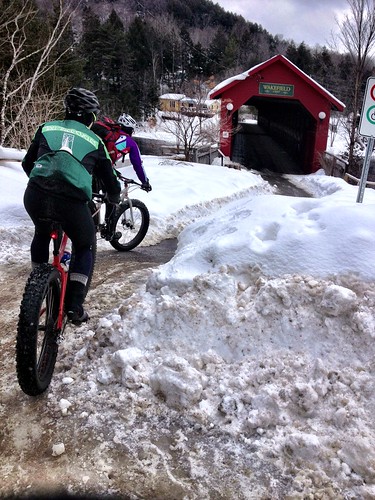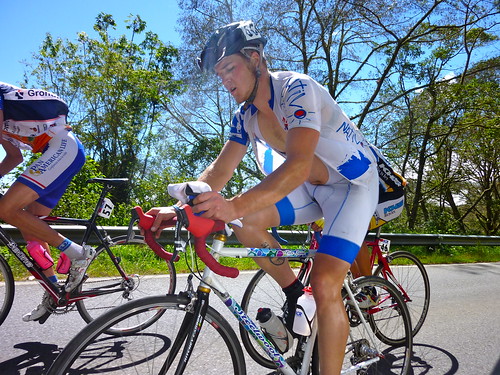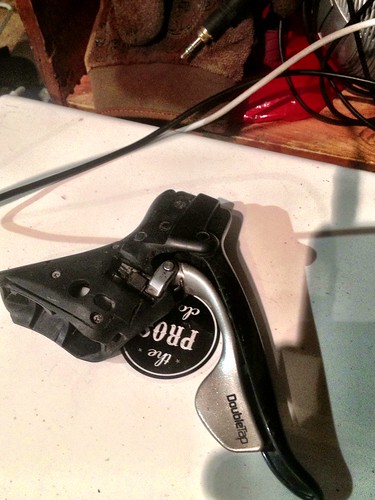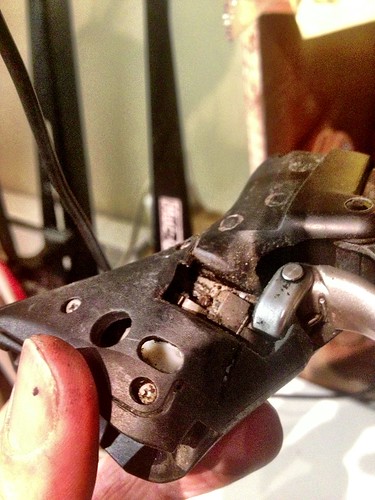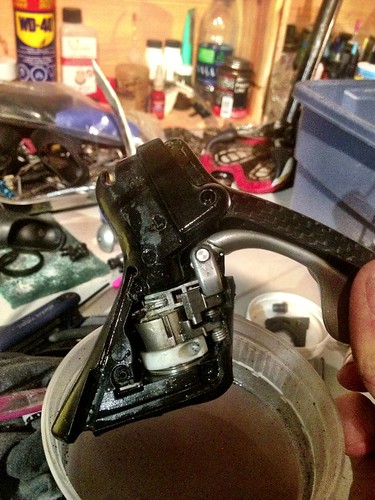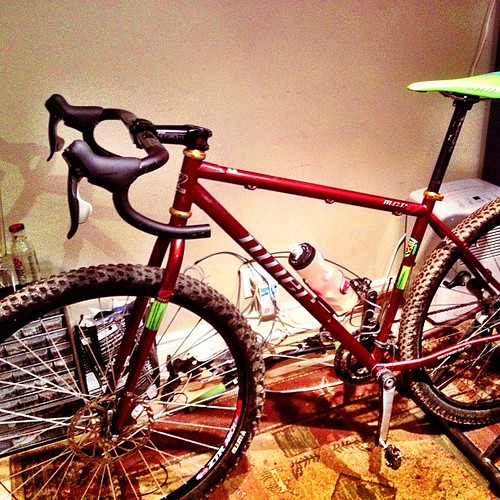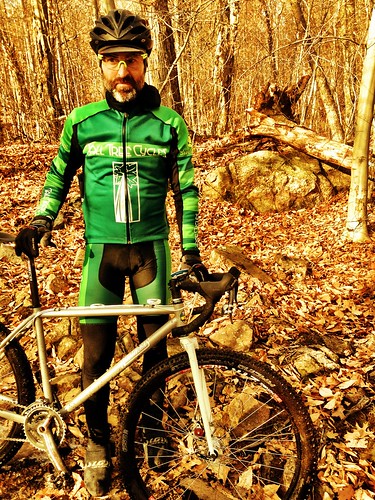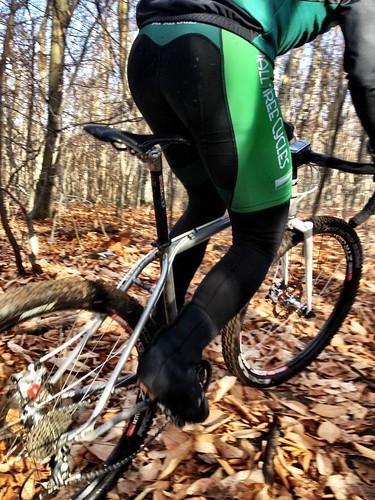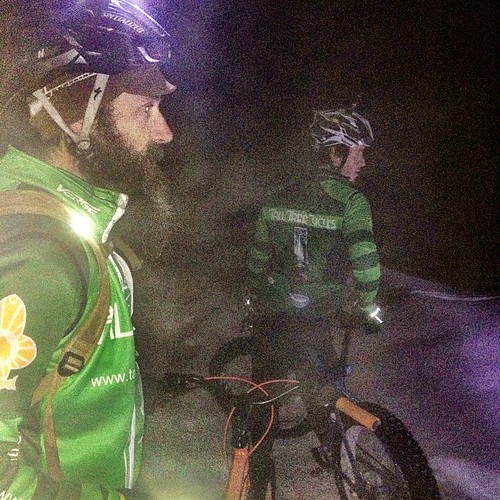
I've been meaning to write a post on dressing for fat biking in the cold for a while, so here it is. I welcome comments about what you all find works. I hope this helps orient those who are new at the whole cycling-in-the-freezing-cold thing.
If you live in Alaska, or anywhere else polar, you should refer to Fatbike.com for advice. Minus 40 degrees Celcius demands different gear than the Ottawa Valley and other similar climes. Here, winter kicks in somewhere between November and December. It has been pretty variable over the last decade or so. Consistent temperatures below freezing tend to begin in late November, if not early December. At the coldest, we get down to about -35 degrees Celcius on occasion, but a typical 'cold' day is about -25 Celcius. Those days have not been terribly frequent over the last few years, with this year as an exception. I rode to work one day at -32...not pleasant.
If you are new to riding in the winter, you will have to start with your hands and feet. While many in very cold climes opt to use thick boots and platform pedals to get the power down, that set-up has tradeoffs. Likewise for clipless shoes or boots. If you will be riding actual singletrack trails, you might like the added control clipping affords. I can attest that switching from platforms to clipless last season made a noticeable difference in control. The challenge is now staying warm.

Lets establish a few principles:
- You can be dry and warm or wet and warm; take your pick, depending on:
--- how long you are going to ride
----- if for only 1 hour or so, close to a car or warm house, you don't need to worry too much about being wet.
----- if you are going out for longer than an hour or so, and/or won't be very close to a warm space, you will want to stay drier. If you get all worked up and wet, then have to ride home on a windy road, you will suffer. OR, you can opt to be wet and keep it in. This is the 'garbage bag method,' used by some endurance fat bikers. You trap in the heat and moisture with plastic, then cover that with insulation. As long as you don't stop for too long, you're good. I don't think this approach makes sense for us Ottawa-area riders doing 1-4 hour rides.
- Layer.
-- Thin layers out of breathable fabrics against the skin, insulating layers as you move out, then windblocking layer on the outside for exposure to wind. In the woods, at low speeds, windblocking layers are not always required. Try a vest over a couple layers to allow the arms to vent excess heat. Keep a shell in your pocket or pack to retain heat once your intensity goes down. That might be the end of the ride, as you are about to drive off, or perhaps at a point where you will be exposed to greater wind and speed for a long descent or road ride home.
- Don't be warm before you start moving.
-- You should not feel toasty in your riding gear while you are standing outside, stationary. If you are comfy, you are overdressed for riding. Lose a layer.
---- If your effort level will be pretty constant for your whole ride, and conditions are expected to remain consistent, you won't need to worry much about changing your layer; assuming you get it right to start with.
- Wool.
-- Specifically, merino epic wool, from a source that treats their sheep with respect.
---- Thin base layers against the skin work really well to regulate your core temperature. High quality merino socks work well too. Merino skull caps and neck buffs likewise work well in most conditions.
- Silk.
-- For glove liners, silk seems to work better than merino for regulating temperature and moisture. Some use it for base layers; I don't have any, so I can't testify to that.
- Cashmere.
-- I am not advocating cashmere in general (being opposed to the subjugation of animals). However, like Iain, you might have a sweater or vest hanging around. According to Iain, it works incredibly well as a mid-layer. Repurposing old pieces is better than buying anything new, in ecological terms, which for some, are also ethical terms.
- Neoprene for wet.
-- If you are going to be wet for a while, you will be cold if your energy output is not really high. You need neoprene.
---- Use neoprene gloves to trap water and keep it warm, as in wetsuits.
---- Use a neoprene face mask when you have to cover up. They have holes in them for CO2 and vapour to pass through.
---- Neoprene socks actually work pretty well too.
---- Some shoe covers are neoprene. They are ok.
- Oversize.
-- Shoes/boots, to fit larger socks with room to spare. You need some air space in the system.
-- The same applies for gloves and mitts; don't make them tight.
Goggles over your eyes when its cold.
-- Eyes and skin around the eyes are sensitive. Cover up with goggles on the cold days, and you'll feel much warmer overall, and protect your eyes from branches and attack squirrels.
---- Look for models with
nose and upper cheek coverage, this makes a big difference.
- Bring spare stuff.
-- When the weather is changing, and/or your speed and/or pace will change frequently.
-- Along with clothes, bring:
---- spare socks if there is danger of a soaker,
---- an emergency blanket and chemical warmers if there is a chance of an injury in an exposed or remote(ish) area.
---- enough water and food to cover a bit more time out than planned, if not close to home.
---- a multi-tool, glueless patches, a pump, a master link for your chain, and a tube.
---- Its good to have a cell phone.
There are a variety of offerings out there labeled 'winter cycling shoes/boots.' I have a pair of
Shimanos, which are GoreTex. I primarily purchased these for fall and spring riding and racing, but pressed them into service for fat biking. While they make riding clipless possible, they don't make it warm. I use a pair of Superfeet 'insulated' insoles to bump up the warmth, and sized them large enough for thicker than usual socks; ski socks fit. However, if I'm out for longer than one hour in colder than -5, my feet will get cold. At -15, they'll be quite cold. -25? No go, I'll freeze, so I can't ride. Adding booties would bump up the heat a bit, but they tend to get mangled when you step off, so you have to resort to taping them to keep them in place. I use a pair of
short gaiters to cover both the tops of my shoes and the cuffs of my
Endura Singletrack pants.
The Endura pants are not waterproof, barely water resistant. Generally, that's not an issue; if its raining I'll ride inside. These afford enough space in the knee to fit in the
661 Kyle Strait knee pads I always wear. After nearly ripping my knee cap off on my first ever fat bike ride a couple years ago (on Brad's bike), I decided knee pads were essential. Rocks are hidden by snow, and knee-to-stem impacts are not uncommon. Better to be proactive.
Ski socks and a pair of knickers with chamois go on under the pads and pants. Rather than cinch the pants super tight, I use a pair of
Chums suspenders, which work great.
Up top I wear multiple merino layers, as outlined above. I'll often wear a poly-something long sleeve jersey on to of 1-3 base layers, then either a jacket or thick vest over that; our Tall Tree team kit works well. Its all fine tuning, depending on the weather and where I'll be riding. In Kanata Lakes I always layer for more breathability and less windstopping than when I ride the local paths in the city. The intensity in Kanata is much higher, yet the speed lower and exposure to wind minimal. In contrast, riding the local paths is often quite windy, and about twice as fast (self-made windchill).
On my hands I wear a variety of gloves, from
silk liners with
WindStopper fleece gloves over top, to WindStoppers inside
wind blocking lobsters, to my new
Black Diamond Guide monster mitts, and about 63 other combinations in between. While
bar mitts/pogies are practical for trekking-type riding, I don't consider them practical for singletrack, or anywhere else where crashing is expected. If your hands are always cold, and you don't grab trees or crash much, these could be for you.
On my head I either wear a merino scull cap or merino toque, depending on the cold. These are encased by a
snowboard helmet with visor and goggle clip, perfect. Goggles are an old pair of Oakleys with an add-on shield.
I think that covers it, head to toe. Did I miss anything? Don't say chemical heaters, that's cheating!
Enjoy the snow, spring's on its way!




